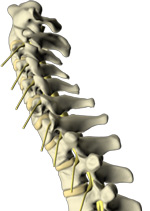All About an Abnormal Concord, NC Cervical Spine
- a disc condition in which tearing of the elastic fibers of the interverterbral disc causes pain and sometimes allows swelling of the disc to compress a nerve, resulting in leg pain (sciatica).
- a non-disc condition due to articular facet joint irritation at the motion areas of one vertebra with another.

- thinning of the disc space (disc degeneration / arthritis)
- misalignment of facet articulations (subluxation)
- narrowing of the spinal nerve opening (stenosis)
- compression of the spinal nerve root via the escape of the nucleus pulposus' center (disc herniation / non-contained disc) that chemically or mechanically presses on the nerve
- compresssion of the spinal nerve root via the nucleus pulposus' center pushing the outer fibers (anulus fibrosus) into the spinal canal and onto a spinal nerve (disc herniation / contained disc)
- compression of the spinal nerve root that results in arm pain (radiculopathy)
Other conditions due to cervical spine issues include
- Klippel Feil Syndrome - the fusion of vertebrae into bony blocks that restrict movement of the neck and spine and possibly progress to greater pain later in life.
- Headache - pain radiating from the neck or shoulder area due to compressed nerves from the pain-producing problems listed above.
- Persistent Post Surgical Pain -Surgery may have hastened pain relief though the pain has returned in the same or oftentimes adjacent structures.
- Whiplash-type injuries - Quick flexion-extension forced movements as in moving vehicle accidents stress the cervical spine and cause pain.
- Myelopathy - a functional or pathological change in the spinal cord itself, resulting in nerve damage. Myelopathy due to late stage cervical disc disease is the gradual loss of nerve function due to disorders of the spine that compress the spinal cord.
You must understand that it takes three months for a torn disc to heal well enough to allow you to return to daily activities like prolonged ironing, painting, holding a phone, etc. Now that doesn't mean that you will have pain for three months, but rather that it takes that time to heal whether you feel pain or not. The first three to four weeks of concentrated in-office treatment, therapies, and at-home care are designed to allow the best opportunity for your disc to heal quickly.
In office, Pure Chiropractic uses Cox Technic Flexion Distraction and Decompression to lower the pressure in the disc so the nucleus pulposus returns to the center of the disc, aid in the healing of the torn anular fibers, and drive out chemicals that irritate and inflame the spinal nerves.
Contact us for relief of your cervical spine pain.
